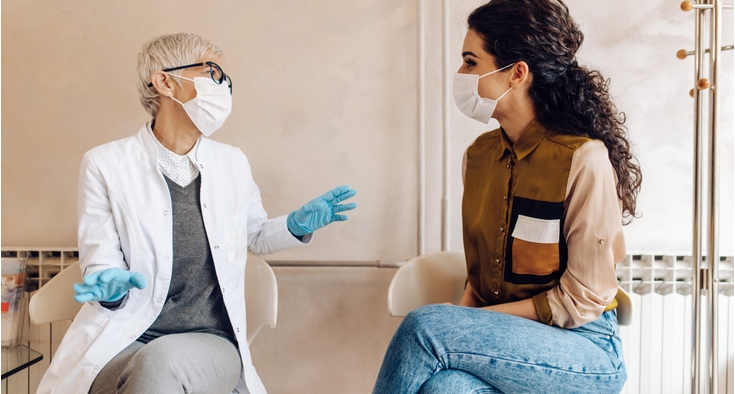We women hear it every few years during our annual gynecological exams: “All right, you’re due for your Pap test.” If you’re over 21, the test – and that little internal pinch that accompanies it – is probably nothing new to you.
The Papanicolaou test, known as a Pap test or Pap smear, is administered when your OB-GYN inserts a speculum into your vagina to see your cervix while collecting cells from the outside of your cervix with a medical stick or brush.
This routine screening is critical for catching abnormalities in the cervix that could lead to cervical cancer. This type of cancer has two primary causes: The main cause is HPV (the human papillomavirus is the most common sexually transmitted infection), followed by glandular cell mutations (which are unrelated to HPV and can lead to adenocarcinoma).
Pap tests can also be used to diagnose other infections like trichomoniasis caused by a parasite, bacterial vaginosis, chlamydia and gonorrhea. This screening test is recommended for women ages 21 to 65, especially those who are sexually active. (Read: Not only those who are sexually active.)
And even if this experience feels like nothing new, there are certain things – some straightforward, some surprising – you should know about Pap tests. Here are five.
Start with your OB-GYN to book a Pap test.
1. You should prepare for a Pap test
To make sure that your clinician is getting the best sample, no douching and do not have sexual intercourse the night before.
Vaginal medication, spermicidal foams, creams and jellies should also be avoided for about two days prior. Lastly, try not to get your test done during the heavy part of your period. All of these precautions help you avoid false-negative test results.
2. You should get a Pap test at least every three years
While doctors used to recommend a Pap test annually, the American College of Obstetricians and Gynecologists updated its guidelines in 2020 based on evidence that shows cervical cancer takes many years to develop. A Pap test detects these slow-growing changes over time.
Annually, about 300,000 American women are diagnosed with cervical precancers that need treatment. The good news: Treating invasive cervical cancer in the early stages before it spreads to other tissues and organs bumps the five-year survival rate from 56% to 92%.

Dr. Matt McDonald, a gynecologic oncologist with Novant Health's Cancer Institute - Elizabeth, emphasizes that in your "off years" between Pap tests, it is still important to see your OB-GYN, who is important part of your wellness team. A routine visit is a great time to ask questions about your sexual health, such as pelvic pain, abnormal bleeding or birth control.
“There is concern in the medical community that women may think they don’t need to have their annual OB-GYN visit. That they only need to see their gynecologist every five years,” McDonald said. “This visit is more than just a screening for cervical cancer. It’s also a pelvic exam, a breast exam and a check of the uterus and ovaries for cancerous masses.”
3. Your clinician may recommend combo HPV/Pap testing
A common recommendation for women between the ages of 30 and 65 is to co-test, meaning you'll receive an HPV test and a Pap test at the same time. An HPV test is completed using the same method as a Pap test, using a swab or brush on the surface of the cervix, and checks for the strains of HPV that commonly cause cervical cancer. The American Cancer Society recommends HPV/Pap co-testing every five years, or a Pap test alone every three years.
Even women who have had the HPV vaccine may receive this recommendation, since there are many strains of HPV, which can cause several forms of cancer, including anal cancer. The plus side: co-testing is more adept at detecting abnormal cells or cervical cancer than the standard Pap test.
4. More frequent testing may be suggested for women who have risk factors
As a precautionary measure, women who have multiple sexual partners, are immuno-compromised, have had an abnormal Pap in the past, or have been treated after an abnormal Pap may be advised to get tested annually.
Conversely, if you're over age 65 and don't have a history of abnormal Pap tests, you may not need the screening anymore.
“Women older than 65 with no history of abnormal cell growth for the last 20 years and women who have had a hysterectomy and no abnormal test results for the last 20 years do not need further cervical cancer exams,” McDonald said.
5. An abnormal Pap test doesn’t instantly mean you have cervical cancer
Anyone with a cervix should know that it's common to have an abnormal Pap test.
While there are degrees of abnormality, the most standard situation is the detection of an atypical cell of undetermined significance, or ASC-US. The next step is typically a colposcopy, a procedure that allows for a closer look at the cervix using an instrument called a colposcope. While a Pap test can reveal atypical cells, the colposcopy will help determine to what degree the cells are abnormal.
Ultimately, both Pap tests and additional testing are positive steps. Doctors are trying to catch cervical abnormalities earlier than they used to. They also want to be able to diagnose an early problem that’s very treatable and not necessarily recurrent before it becomes cancer.











